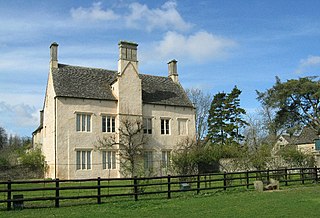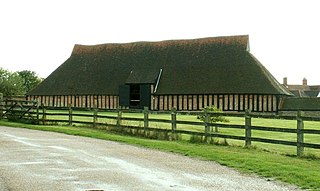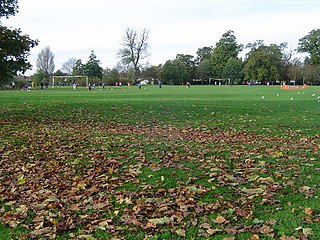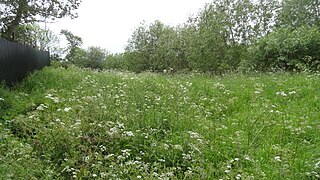
Addington Palace is an 18th-century mansion in Addington near Croydon in south London, England. It was built on the site of a 16th-century manor house. It is particularly known for having been, between 1807 and 1897, the summer residence of the Archbishops of Canterbury. Between 1953 and 1996 it was occupied by the Royal School of Church Music. It is now a conference and wedding venue and country club, while the grounds are occupied by a golf course.

Lambeth Palace is the official London residence of the Archbishop of Canterbury in England, in north Lambeth, on the south bank of the River Thames, 400 yards south-east of the Palace of Westminster, which houses the Houses of Parliament, on the opposite bank.

North Harrow is a suburban area of North West London, situated north-west of central Harrow within the London Borough of Harrow. Its residential roads have expanded from North Harrow tube station, a station on the Metropolitan line of the London Underground which is one stop away from Harrow-on-the-Hill station in Harrow town centre. Before North Harrow tube station was opened and the suburb developed, the area was originally known as Hooking Green.

Shapwick is a village on the Polden Hills overlooking the Somerset Moors, in the Sedgemoor district of Somerset, England. It is situated to the west of Glastonbury.

Harrow on the Hill is an affluent residential area in north west London, England, and part of the London Borough of Harrow. Independent boutiques and restaurants dot the area, which is rich with historic architecture; offering a village atmosphere. The name refers to Harrow Hill, 408 feet (124 m). It is located some half a mile south from the modern town of Harrow. The area is home of the famous Harrow School.

St Mary's, Harrow on the Hill, is the Borough and Parish Church at Harrow on the Hill in northwest London, England. It is a Grade I listed building.

Cogges Manor Farm is a one-time working farm in Cogges near Witney in Oxfordshire, England, now a heritage centre operated by a charitable trust and open to the public.

Cressing Temple is an ancient monument situated between Witham and Braintree in Essex, close to the villages of Cressing and White Notley. It was amongst the very earliest and largest of the possessions of the Knights Templar in England, and is currently open to the public as a visitor site. It is the location of three Grade I listed Medieval barns, one of which is the oldest standing timber-framed barn in the world.

Calcot Manor is a historic building in Calcot, three and a half miles west of Tetbury on A 4135 in Gloucestershire, England, near the junction of roads A46 and A4135. The original building was established in approximately 1300 AD by Henry of Kingswood as a tithe barn annex of Kingswood Abbey. The estate was expanded to include a 16th-century manor house and other buildings. Structures added from the Late Middle Ages to the mid-17th century include a chapel, granary, stables and other buildings. The buildings are all constructed from limestone; which are locally quarried stones that are typically flat and easily stacked for drystone wall purposes.

Headstone is a residential area in London, England, north-west of Harrow and immediately north of North Harrow.
A green buffer exists between Headstone and North Harrow that consists of a moated manor site and football and rugby pitches, making the area mostly separate from North Harrow. However, there are some points of flux and overlap. To the west the area abuts the large and predominantly agricultural pasture of Pinner Park.
Peddimore Hall is a manor house in the Walmley area of Sutton Coldfield in Birmingham, West Midlands, England. It is a Scheduled Ancient Monument and a Grade II listed building. It is now in use as a private residence.

Bentley Priory is an eighteenth to nineteenth century stately home and deer park in Stanmore on the northern edge of the Greater London area in the London Borough of Harrow.

Holmside Hall is an early 19th-century farmhouse and equestrian centre at Holmside, Burnhope, County Durham, England.

Donington le Heath is a village on the River Sence just over 1 mile (1.6 km) south of the centre of Coalville in North West Leicestershire. Donington is contiguous with the village of Hugglescote immediately to the east. The population of the village is included in the civil parish of Hugglescote and Donington le Heath.

Manor Farm is a 22-acre (8.9 ha) historic site in Ruislip, Greater London. It incorporates a medieval farm complex, with a main old barn dating from the 13th century and a farm house from the 16th. Nearby are the remains of a motte-and-bailey castle believed to date from shortly after the Norman conquest of England. Original groundwork on the site has been dated to the 9th century.

Harmondsworth Great Barn is a medieval barn on the former Manor Farm in the village of Harmondsworth, in the London Borough of Hillingdon, England in the historic county of Middlesex). It is north-west of fields and the A4 next to Heathrow Airport. Built in the early 15th century by Winchester College, it is the largest timber-framed building in England and is regarded as an outstanding example of medieval carpentry. It was described by the English poet John Betjeman as the "Cathedral of Middlesex". A similar though smaller barn is part of the Manor Farm complex in Ruislip.

Northolt Manor is a 1.8 hectare Scheduled Ancient Monument, Local Nature Reserve and Site of Borough Importance for Nature Conservation, Grade II, in Northolt in the London Borough of Ealing. It is owned and managed by Ealing Council.

Down Barns Moated Site is a Scheduled Ancient Monument in Northolt in the London Borough of Ealing. It is the site of a medieval manor house, which does not survive, but the moat does. It was probably in existence by 1388, and is thought to have been abandoned in the sixteenth century. Excavations were undertaken in the 1950s and 1960s, but the results are not known.

Frampton Court is a Grade I listed country house and estate of about 1,500 acres (610 ha) in Frampton-on-Severn, Gloucestershire, England. It has been owned by the Clifford family since the 11th century. The main buildings are the 18th century Frampton Court and, on the opposite side of the village green, Manor Farm. The gardens at Frampton Court have a Gothic orangery and ornamental canal in the style of William Halfpenny. The two houses, barn and orangery are all Grade I listed buildings in their own right, while the Gatepiers and Gates are Grade II* listed.


























